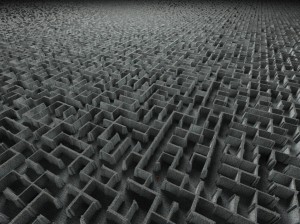First of all, this is a sequel. If you haven’t read the preceding novel A Wizard of Earthsea, then go do that right now. It’s not long. I’ll wait…
It’s wonderful, right? I remember how the prose grabbed me when I first read it, and it still grabs me that same way. It’s like The Gunslinger in that way; it feels truly, effortlessly ethereal. The text exists outside of time, as do all great fairy tales. And that’s the one problem with the sequel. Much like The Drawing of the Three (a great book in its own right), The Tombs of Atuan fails to perfectly maintain the style of A Wizard of Earthsea. It’s absolutely the same world and the characterization and world-building remains consistently excellent, but that rhythmic, trickling, watery prose has given way to an equally stark but much more traditional novelistic style. It’s a weak criticism, to be sure. Styles change and I’m afraid that that sort of tonal resonance may be a once-in-a-lifetime achievement for an author. It’s been so with King, and it may prove to be so for LeGuin.
Luckily, as I alluded to above, the book itself remains solid and even innovative. Certain stylistic flourishes I expected never materialized, but the way LeGuin wove the story was still magical. It’s a subtler sort of genre inversion she works than that of Miéville. Miéville plunges you headlong into a world that is just as different tonally and superficially as it is under the hood. LeGuin’s creativity is much more human, much more classic. She doesn’t build Earthsea from the ground up at the start and you don’t realize how distinct it is from the Tolkien master style until you find yourself in a hole in the world with her as she creates and fills it in in front of you, and I have to imagine that’s how storytelling has worked from the beginning.
The island of Atuan was one such hole, and so was the larger role of women in the world. The edition I read has an afterword by the author herself, and she explains the cultural context in which she wrote The Tombs of Atuan, one in which female characters lacked power and agency. We’ve come a long way in giving female protagonists power; we have warriors and sorceresses and witches and goddesses of unfathomable destructive power, (almost) every bit as potent as the boys, but modern authors still struggle to give their creations agency.
And that may be the most impressive thing about the book: that LeGuin does not simply imbue the girl Arha with agency from the beginning, but allows her to self-actualize against a backdrop of orthodox masculinity. Ged is a player in the story of Arha’s coming into her own, and it enriches his own ongoing story as a supporting character in this sequel.
The Tombs of Atuan is almost exactly the sort of superficially evocative, wonderful read that you’re already expecting, but with the lights off, in the deep, labyrinthine catacombs that undergird it, there is something altogether different and important happening. There are more holes in Earthsea to be filled in subsequent books, but the complicated, overdue pubescence she forces onto genre convention with this book may prove to be Earthsea’s most important, impressive legacy.
“When you eat illusions you end up hungrier than before,” expounds Ged at one point in the story. “It’s about as nourishing as eating your own words.” An insight, yet LeGuin’s words make me feel fully fed.

